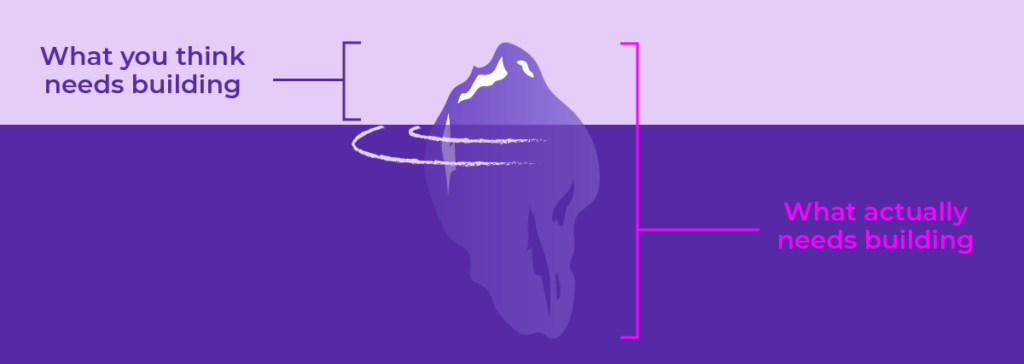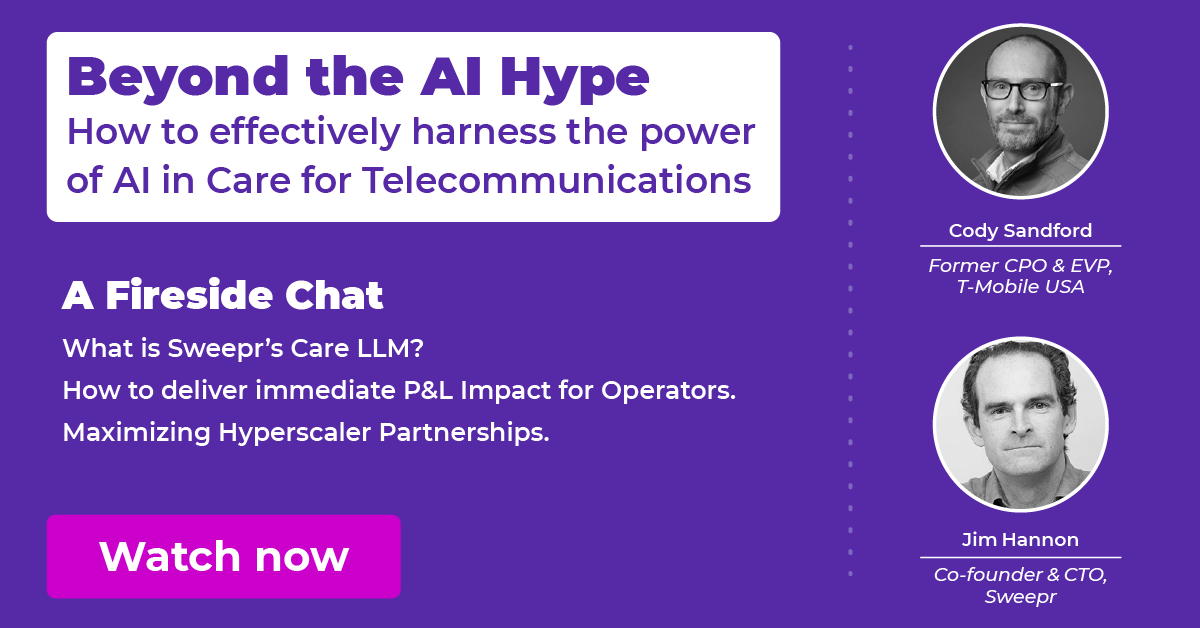“Our IT organization will build this for us”
At Sweepr we hear this, or something that sounds like this, a lot.
As a matter of fact, it is almost formally a part of our sales cycle.
Recognizing the need for a platform is already a sign that the organization appreciates the strategic necessity of managing an ever expanding number of digital care journeys. These organizations are fully embracing the opportunity to make a paradigm shift from being a contact center centric care organization, to one that is digital first. In doing so, they are aiming for 50-60% call deplacement and a material reduction in call handling times. However, the key question here is whether you should attempt to build from scratch such a key element of your customer support infrastructure, or whether now is the time to look to buy a proven solution from the market, in the same way you might consider building your own BSS or Billing Engine or Content Management solution.
the key question here is whether you should attempt to build from scratch such a key element of your customer support infrastructure, or whether now is the time to look to buy a proven solution from the market
Build vs. Buy
The Build vs. Buy question always gives way to some lively debates. The main arguments are well known. As a general statement, what you gain from buying a mature COTS product like Sweepr is:
- Faster Time to Market – It is ready now and typically provides tools that support faster turnarounds
- Flexibility – A solution that anticipates and can evolve with your needs as opposed to have to go back to development for every changes needed
- A solution that comes at no or limited internal cost to you if you pick a solution like Sweepr which is focused on improving operational efficiency
- Opex vs. Capex
- Shared cost across the entire customer base for building the solution
- A team whose only focus is to deliver the best product possible based on market feedback as opposed to a project as part of your IT organization that is not specialized in this topic and has multiple areas to tackle other than Digital Customer Care. This Expertise can also come in the form of Best practices, customer success, shared stories that will help make your implementation better
- Training – The COTS product is documented and has available training resources

More specifically, the advantages of the Sweepr Platform are:
- A no-code solution with an optimized GUI that will allow your customer care teams to control the care experience granularly without having to depend on IT.
- Native multi-channel support with one place to consistently manage all channels and languages without creating silos
- A solution that scales and allows you to easily adapt to the use of a new channel and the need for an integration to a new data source
- A company that offers support based on design expertise, customer care experience and market knowledge
- Intelligence in customer care with a system that learns and has memory of past interactions
- Built-in diagnostic tools such as speed tests, latency measurements, …
- Built-in CSR context data in the cases where digital containment fails
By building the Digital Customer Care
platform yourself, you will own it,
but at what cost?
You have now committed to having staff, a full software development team that will deal with building and supporting a product based on your initial stated needs. What happens when those requirements evolve? When there are new tools or channels to support? Are the tools that they built to your liking? Are they efficient and are giving your Customer Care team the autonomy that they need? Are they built based on market and industry feedback or in a vacuum? And last but not least, when will it be ready to support you to the full extent of already existing solutions? I have witnessed prospects spend millions of dollars to develop a sub-par product that only becomes available more than a year after the fact. All of this to say that more often than not, a company should not take the Build route.
Build-ish vs. Buy
In the case of the hybrid solution that I described earlier, or as I like to refer to as a “Build-ish vs. Buy” scenario, the organization does not fully commit to running a software team. It relies on IT resources to vet, administer, at times host, and maintain various IT tools, sometimes from disparate vendors, to offer some level of functionality. This approach allows for a faster time-to-market than the typical Build approach and avoids some of the drawbacks described in the Build vs. Buy section. However, it is far from solving for all of them and also introduces new ones.
Among some of the leading tools we see being used in the “Build-ish” case are the stacks offered by Google, Amazon and Microsoft to a lesser extent (Google CCAI & DialogFlow and Amazon Lex and CCI to name a few).

Prepare yourself to be confused. I know I was. So much so, that I had recourse to Bard and ChatGPT to help me decipher these offerings. The bottom line is that they can do a lot of things for you. Most of the time, they have overlapping functionality meaning that you pay for the feature in both products (CCAI & DialogFlow for example) and that you will have to sort out in which product you should use a specific functionality and make it a common practice across your organization to keep things consistent.
Although these offerings are theoretically able to provide pretty decent levels of CX through the way they present the content and personalize it, more often than not, they are just used to create chatbot experiences with no personalization. They collect information from Knowledge Bases and regurgitate them back to the end user which is a far cry from delivering outstanding CX. They are typically excellent at interpreting intent but mainly deal with simplistic issues.One of the reasons for that is the lack of consultancy and best practices – you purchased IT solutions; They do not come with outside opinions, best practices or recommendations about your business practices and your approach to CX. The other leading cause of those simplistic implementations is that. Although highly flexible, they require coding as soon as one tries to implement something a bit elaborate.
you purchased IT solutions;
They do not come with outside opinions, best practices
or recommendations
As stated above, these products are still IT solutions. That means you need to install/enable them, integrate them to your own system yourself and monitor and maintain their health.
One of Sweepr’s customers has a large CCAI initiative which is over a year in the works. It is still at least a year from going live and solely to handle a fragment of their customer care needs. Instead of relying only on CCAI, they instead implemented Sweepr in conjunction with CCAI to meet their needs. Sweepr goes deeper, it is smarter, more usable and ready today. Sweepr handles the complex issues and leaves the FAQ type questions up to CCAI.
Most of these solutions will also claim to support personalization and dynamic decisioning. To be clear, they do but they do not support this in a no-code environment. You will need to roll-up your sleeves and write code in the specific syntax supported in order to get these tools to do exactly what you need. This is very feasible but this does not contribute to operational efficiencies where your care team will be autonomous.
On the opposite end of the spectrum, leveraging data is at the core of what Sweepr does:
- We integrate to our customers’ backend systems / middleware layer
- We generate data points ourselves by calculating things such as Technical Skill Level or Digital Patience
- Through our embedded diagnostic tools, we measure (depending on the channel) connection speed, latency, detect devices on the network and more
These data points are then available to support dynamic decisioning and personalization in a no-code environment where the Sweepr GUI will support everything you need.
Any Enterprise organization will quickly realize that the
cost per usage of any of these solutions will end up reining in initiatives
Last but not least, let’s talk about money since the primary motivation for implementing digital care is originally cost reduction. All these solutions are priced based on usage. That makes them appealing for a small business. However, any Enterprise organization will quickly realize that paying for hosting, the cost of the Compute involved and the cost per usage of any of these solutions will end up reining in initiatives for new use cases and channels deployments because of the additional costs incurred. Moreover, the cost fluctuates with peaks and valleys which makes it hard to forecast.

Sweepr is more Enterprise-focused. We prioritize Enterprise deals by offering a model where you pay for the customer base and have unlimited access to the platform. Your success is our success and our team works with you to advise on missed opportunities and where the solution can be improved or have a bigger impact.
Conclusion
“Our IT organization will build this for us”
From a sales perspective you might think that these words mean this is the end of the discussion. However, we have observed a pattern where our prospects come back to the table within 6 months to 2 years depending on how far they are willing to take their explorations and what timeline they have given to their IT organization.
I can only encourage speaking with our team without delay. Should you decide to build this internally, you’ll have at least gained that time on the timeline but needless to say that if you want to start now, we and our platform are ready for your project to go live promptly

